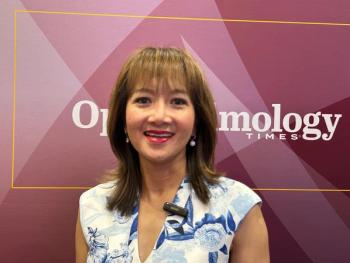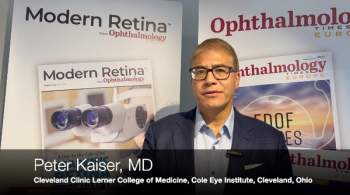
Diagnostic Imaging of Nonexudative Neovascular AMD
A panel of experts discusses nonexudative neovascular AMD and challenges associated with diagnostic imaging such as OCT-A and fluorescein angiography.
Episodes in this series

Charles C. Wykoff, MD, PhD: I’ll bring up the question of this new category of AMD [age-related macular degeneration] that many have described. I really like the paper in particular by Dr Phil Rosenfeld talking about this nonexudative neovascular form of AMD. These type 1 membranes, these CNV [choroidal neovascularization] lesions that grow up between broken membrane between the RPE [retinal pigment epithelium], have been called confluent drusen for years. Just a double layer sign on structural OCT [optical coherence tomography] and then OCT-A could pick out the lesions, but there’s no exudation. There’s no subretinal fluid, and there’s no intraretinal fluid. There are typically no symptoms with these lesions. It turns out that 10% or 20% of patients with GAA and intermediate drying B may harbor these lesions. It’s fascinating to be able to pick these up clinically. When you see a lesion that might be this nonexudative form of neovascular AMD, do you think about those treating those eyes? How do you manage those eyes, Mark?
Mark P. Breazzano, MD: That’s a great question. It shows how amazing it is to be in our field given this explosion of not only treatments but, as you are mentioning, the diagnostic capabilities we have with OCT-A and understanding things we didn’t know. You’re absolutely right: OC [optical coherence] angiography has allowed us to image and see these lesions. It’s not something I would go after if it doesn’t already have a neovascular exudative component, but I will follow them much more closely. Instead of bringing them back in 6 months or so, I am much more aggressive with my observation, I guess you could say. I would have them come back in just a few months and see how that’s going, and at the first sign of leakage, I would definitely initiate treatment early on. But it’s quite remarkable with the OCT-A and that we’re able to see these.
Diana V. Do, MD: Sophie, Charlie, I had a question about OCT-A. I know a lot of our friends and colleagues have these amazing OCT-A images. When I use it in day-to-day clinic, a lot of the images are challenging to interpret. I still rely on my good old fluorescein angiogram when I want to make the diagnosis of active wet AMD. Am I the only 1 who has trouble getting good OCT-A images, or do you have these cases too?
Sophie J. Bakri, MD: I’m glad you brought this up for discussion, Diana. In most cases, OCT-A is difficult to interpret. You may see a lesion there, but you may not know if it’s leaking or not. I’m old-fashioned. I like fluorescein, and I like OCT. But in select cases that are leaking on fluorescein but perhaps the OCT doesn’t show the lesion as well, I get an OCT-A. The reason is that if I can see the lesion on OCT-A, then that is a noninvasive way of monitoring that patient, because I certainly don’t want to do serial fluorescents on my patients. I found it helpful in that situation. I found it helpful in other conditions such as CSR [central serous chorioretinopathy], which has given me some nice CNV membranes to look at and, in some cases, vitelliform dystrophy. But in run-of-the-mill wet AMD, I wish I could replace fluorescein angiography with OCT-A, but I don’t think we are there yet. There are few select individuals in the United States who have big OCT labs and an army of help to find that lesion. But that’s not routine practice.
Mark P. Breazzano, MD: Something that can help, at least in my limited experience with OCT-A, is that when patients are getting the OCT-A, usually it’s their last test. Oftentimes their eyes can be even more dried out, especially in this older population that has such dry eyes. I’ll usually have them relubricate the eye, and then—also after the scan—I make sure the proper segmentation was done on the OCT-A itself. Sometimes that will bring out the lesion or whatever you’re trying to look for. It’s helped me in some cases. But as you said, sometimes it can be very challenging, and we just do the best we can with what we got.
Charles C. Wykoff, MD, PhD: I agree with everything that’s been said. Diana, I have the same challenges. I’m used to being efficient looking at our structural images on OCT. You can glance at an OCT efficiently and interpret it. But with OCT-A, it takes a long time to resegment and to correct and look at the different layers. It’s a very time-consuming effort to look at those. Unfortunately, I find myself moving away from fluorescein. I say unfortunately because I wholeheartedly agree with Sophie. Before the COVID-19 era, I would get a fluorescein on almost all my patients at baseline, and then rarely after that unless there was some change. Even now, I must admit, if it’s obvious I often will skip the fluorescein. I feel a little guilty saying that because I enjoy having those baseline images. I’m just trying to be efficient. I look forward to OCT-A software catching up with the structural OCT software that we have.
Transcript edited for clarity.
Newsletter
Don’t miss out—get Ophthalmology Times updates on the latest clinical advancements and expert interviews, straight to your inbox.



















































.png)


